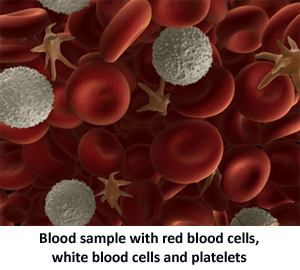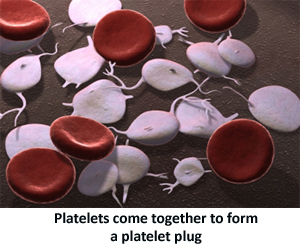Understanding How Blood Works
Parts of the Blood
 Our blood has two main parts – blood cells and plasma. The plasma is the liquid part of the blood. It is mainly water. It contains proteins, fats, salt, and other substances. Some of the proteins are important in blood clotting.
Our blood has two main parts – blood cells and plasma. The plasma is the liquid part of the blood. It is mainly water. It contains proteins, fats, salt, and other substances. Some of the proteins are important in blood clotting.
The blood cells are red cells, white cells, and platelets. Red blood cells carry oxygen to all parts of the body. White blood cells help fight infection. Platelets are tiny cells that have a big job in stopping bleeding. Proteins in the blood called clotting factors work to form a clot. To understand bleeding disorders, you have to know how the proteins and the platelets in the blood work together.
Our bodies make platelets inside the bone marrow (the tissue in the center of a bone). Platelets are disc shaped cells that are so small they can only be seen with a microscope. They are less than half the size of a red blood cell. One drop of blood contains tens of thousands of platelets. About 70% of your body’s platelets float around in your bloodstream. The other 30% are stored in an organ behind the stomach called the spleen. Each platelet travels in the bloodstream for seven to ten days. Then, if it has not been used to make a blood clot, cells in the spleen and liver destroy it. Every day, 200 billion new platelets enter the bloodstream to take the place of those that are used or destroyed.
Stopping Bleeding
Blood travels around inside your body through blood vessels. These include veins, arteries, and capillaries. You can think of the blood vessels as pipes and tubes carrying blood to all parts of your body. When one of these pipes is damaged, the blood can spill out. Sometimes this happens on the outside when your skin is cut or scratched. Sometimes it happens just under the skin, causing a bruise. Other times the blood can be leaking out of a blood vessel inside another part of the body. In all cases, the body must work to stop the leak and repair the pipe.
 First, the blood vessel gets smaller
First, the blood vessel gets smaller
The first thing the body does is make the blood vessel smaller, so less blood is going through it and leaking out. Muscles in the wall of the blood vessel make this happen.
Next, a Platelet Plug is Made
The next step in stopping the bleeding is making a platelet plug. A platelet plug is a temporary patch over the leak. Three things must happen to make a good platelet plug: adhesion, activation and secretion, and aggregation. If there is a problem with any of these, a person will have trouble fixing the leak and is more likely to bleed.
-
Platelet Adhesion
In order to make a plug, the platelets floating in the blood must stick to the torn wall of the blood vessel. This is called adhesion.Blood vessels are lined with smooth cells called endothelial cells. When the blood vessel is torn, the blood meets the substance under the endothelial cells. This substance is called collagen. Platelets floating by in the blood are attracted to collagen. They quickly move to the site of the injury.
For the platelets to stick to the collagen, they need a “glue.” The “glue” that sticks platelets to the collagen is a protein in the blood called von Willebrand factor (VWF). The von Willebrand factor (VWF) attaches to the platelet at certain places on the platelet’s surface. These places are called receptors.
Von Willebrand factor is stored in the endothelial cells lining the blood vessels. The endothelial cells release the VWF into the blood.
-
Activation and Secretion
After the platelets stick to the collagen where the blood vessel is torn, they change their shape. Each platelet changes from a smooth disk to a ball shape with long arms that can reach out to other platelets. This is called platelet activation. Activated platelets can stick to each other and to clotting proteins in the blood.Inside each platelet are storage spaces called granules. When the platelet changes shape, chemicals inside the granules are pushed out into the bloodstream. This is called secretion. These chemicals from the granules signal other platelets to come and help. The chemicals allow the next step in forming a platelet plug, aggregation, to happen.
-
Aggregation
To form a platelet plug, the platelets must stick to each other as well as to the blood vessel. This is called platelet aggregation. The platelets form a clump that plugs the hole in the blood vessel.When platelets can stick to the blood vessel (adhesion), change shape and signal other platelets to come help (activation and secretion), and stick to each other (aggregation), a good platelet plug is made. Though it is a complex process, it normally only takes seconds. A platelet plug is only a temporary fix. It can’t last long on its own. A fibrin clot is needed.
Finally, a Fibrin Clot is Formed
A fibrin clot is a good, strong patch over a hole in a blood vessel. It is normally enough to stop the bleeding completely. Proteins in the blood called clotting factors work together to make the fibrin clot. Ten clotting factors are named with Roman numerals (I, II, III, IV, V, VII, VIII, IX, X, XI). Another protein (factor XIII) strengthens the clot even further.
The clotting factors work together to make threads of a protein called fibrin. The fibrin threads weave over the platelet plug to make a strong clot. The body then has time to heal the blood vessel. When it is no longer needed, the body gets rid of the fibrin clot.
QUICK TAKE: Bleeding is supposed to stop after three things happen:
1. The injured blood vessel gets smaller to let less blood through.
2. Platelets rush to the site and stick together to form a platelet plug. The platelets do this through adhesion, activation and secretion, and aggregation.
3. Clotting factor proteins in the blood work together to make threads of fibrin. The fibrin weaves itself into a clot over the platelet plug. This makes a strong seal.
